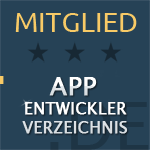
Insight

Insight

Insight
Planning certainty in app projects: How dev slots can make your company more efficient


Julian Giesen
·
8
min read
·
Monday, June 9, 2025


Julian Giesen




Photo - ChatGPT
Whether you are acting as a project manager in a medium-sized company or as the founder of a startup – one thing is certain: App projects require structure, clarity, and predictable processes. Yet, especially in dynamic business environments, this often fails. Developers are overloaded or unavailable at short notice, schedules shift, and budgets spiral out of control. The result: frustration among stakeholders, wasted resources, and lost trust in digital processes.
This is exactly where the concept of Dev-Slots comes in. Imagine you could book developer time like meeting rooms – predictable, calculable, and available exactly when you need it. Dev-Slots are fixed reserved development times that give you maximum control over your project – without a dedicated development department or lengthy contract negotiations.
In this article, I’ll show you how Dev-Slots help you avoid the biggest project pitfalls. You will learn about the specific advantages for your company, how to structure your app projects with this method, and what to consider when integrating it into your existing planning. Because efficient app development doesn’t start with the first code – but with a clear plan.
1. The most common stumbling blocks in app projects
Perhaps you know this yourself: An app project starts promisingly, the requirements are clearly defined – and yet there are delays, bottlenecks, or unexpected costs. These problems are no exception in many companies, but rather the rule. Here are three of the most common stumbling blocks that can jeopardize the success of your app projects:
1.1 Unclear resource availability
One of the biggest bottlenecks in app development is the availability of developer resources. Often, internal developers are already fully loaded or unavailable at short notice. External service providers can rarely respond spontaneously, and onboarding new freelancers takes time. The result: Deadlines are pushed back, and projects lose momentum.
Delays due to lack of developer capacity
Even if you have a good team on board, bottlenecks can occur due to other internal priorities or sick leave. Without planable developer times, gaps in the project flow arise that quickly add up. Every lost day impacts the overall result – especially in agile or MVP-driven projects.
Budget overruns due to lack of transparency
Many companies estimate app projects too roughly: A fixed project price or a non-binding hourly quota – but without real planning certainty, costs usually rise uncontrollably. Unexpected queries, additional loops, or waiting times hit the budget directly and cause costs to spiral out of control.
2. What are Dev-Slots and how do they work?
Dev-Slots are weekly development times that you book for a fixed monthly price. You have a dedicated Flutter developer regularly available to you – predictable, reliable, and exclusively for your project. The model combines the advantages of continuous availability with the flexibility to temporarily scale up as needed.
Definition: Weekly time slots in a monthly model
With Dev-Slots, you book fixed weekly development times – for example, half a day or a full day per week – over a monthly framework. These slots are predefined and billed at a fixed monthly price. You know exactly when your developer is available and what capacities are regularly available to you.
Flexibly extendable: Additional slots as needed
If your project needs to pick up speed at short notice – for a new app version or a conversion optimization – you can simply book additional weekly slots. These additional capacities can be planned flexibly without disrupting the monthly rhythm. This way, you remain agile without sacrificing reliability.
The difference from traditional agency and freelancer models
In contrast to conventional project models with unpredictable hourly quotas or changing contacts, the Dev-Slot model offers clear advantages:
Fixed, weekly developer time at a monthly price
Reliable planning without spontaneous availability gaps
A personal developer instead of changing teams
Flexibly scalable when your demand increases
No surprises with budget or timing
For companies that regularly implement or further develop app projects, this model achieves the perfect balance between structure and flexibility.
3. Efficiency through planability: Advantages for companies
Especially in small and medium-sized enterprises, time is often a scarce commodity – and developer resources even scarcer. Dev-Slots create a real efficiency gain by allowing you to implement projects in a structured, budgeted way with clear time slots. The result: less downtime, less stress – and more output.
Fixed time slots = calculable development costs
With a fixed monthly price and weekly reserved times, you know in advance what services you will get – and at what price. Instead of vague effort estimates, you have full control over your budget. This not only facilitates internal approval but also ensures transparent communication with stakeholders.
Structured project phases instead of chaotic sprint requests
Dev-Slots help you divide your app project into clear, actionable phases. You plan features, tests, or optimizations into the booked weeks. This way, there are no last-minute sprints, but a reliable rhythm, allowing your project to progress step by step – whether MVP, relaunch, or further development.
Flexible access to capacities as needed
The great advantage: If your project needs more dynamism at short notice, you can simply book additional slots. You don’t have to expand fixed contracts or wait weeks for available resources. This flexibility is particularly valuable during phases such as launches, updates, or feedback rounds with stakeholders.
Focus on the essentials: No project management overhead
Since you don't work with changing contacts or opaque agency structures, you also save time in project management. Your developer knows your project, your goals, and your code. This builds trust, reduces onboarding time – and ensures that productive work is truly being done.
4. Case study: A growing digital company with variable development needs
How can Dev-Slots be integrated practically? An example from a digital B2B company shows how structured developer time achieved more structure, better implementation speed, and clear cost transparency – without an internal development department.
Initial situation: A startup with an active app, but without a fixed development team
A young company in the SaaS sector had launched the first version of its app – featuring basic functions for user management, communication, and onboarding. There was a regular need for further development, but having a dedicated development team would have been premature. At the same time, it was difficult to quickly access qualified Flutter development.
The solution: Fixed Dev-Slots + flexible extensions
The startup decided to book weekly Dev-Slots at a fixed monthly price. This provided regular development capacity – without the fixed costs of a full-time developer. New features, technical optimizations, or minor maintenance tasks were implemented directly in the booked slots. During intense project phases – e.g., during a major UI update – additional slots could be quickly added.
The results: Fast releases, predictable development, no surprises
The results spoke for themselves:
Weekly progress instead of development stops
Clear time budget for roadmap and feature implementation
Flexible scaling without long-term personnel commitment
Transparent monthly billing instead of vague estimates
For the team, especially the fixed rhythm was a game changer: With a clear plan of what was realistically achievable each week, even non-technical stakeholders could plan and manage better – without stress or standstill.
To ensure your app remains performant even after many iterations, the article Flutter Performance Tips: How to Optimize Your App offers in-depth techniques for rendering, memory, and profiler usage.
5. How to integrate Dev-Slots into your app project planning
Dev-Slots unleash their full potential when you consciously integrate them into your project planning. Whether you are developing a new app or continuously improving an existing application – with fixed time slots, you structure your development work more efficiently and transparently.
From the roadmap to slot planning
The first step is translating your product vision or roadmap into actionable units. What features, improvements, or maintenance tasks are coming up? With a simple prioritization based on effort and business impact, you can assign these tasks to individual Dev-Slots – for example:
Week 1: UI improvements & bug fixes
Week 2: Revise push notification logic
Week 3: New onboarding feature
Week 4: Testing & analytics integration
This gives you a realistic assessment of what is achievable within the month – and prevents overload or standstill.
Coordination with stakeholders and internal teams
If you are working with multiple stakeholders – e.g., marketing, product management, or external service providers – the fixed slot rhythm helps with coordination. Instead of constantly searching for new time windows, you communicate clearly: “That can be done in week 2” or “For that, we need an additional slot next week.”
Feedback cycles can also be planned better: You can incorporate feedback from the previous week directly into the next implementation without it dragging on for weeks.
Time management and feature prioritization
Since your development time is clearly limited, you automatically learn to prioritize better. What really adds value for the user? What can wait? This clarity not only improves technical implementation but also your product decisions overall.
A bonus: You develop a realistic sense of speed and effort – and can plan significantly more soundly in the future.
Conclusion: More control, less risk – with Dev-Slots to efficient app development
If you want to implement app projects reliably and efficiently, you can’t ignore structured planning. Dev-Slots offer you exactly that: fixed, weekly development times at a monthly flat rate – complemented by flexible additional slots whenever your project needs them.
You not only gain control over budget and time but also over the quality of your implementation. No more constant juggling of resources, no lost weeks due to unavailability – but a clear, planable development process that is oriented to your actual needs.
Especially for startups and SMEs, this is a real advantage: You secure reliable developer capacity exactly when you need it – without personnel commitment or high overhead costs.
If you want to implement your next app project with more calm, structure, and success, now is the right time to switch to Dev-Slots. Take the opportunity to make your product development more strategic – and turn developer time into a plannable resource.
All insights
All insights
“Flutter and the related logo are trademarks of Google LLC. We are not endorsed by or affiliated with Google LLC.”
“Flutter and the related logo are trademarks of Google LLC. We are not endorsed by or affiliated with Google LLC.”
Copyright ©2025. Julian Giesen. All rights reserved.
“Flutter and the related logo are trademarks of Google LLC. We are not endorsed by or affiliated with Google LLC.”





